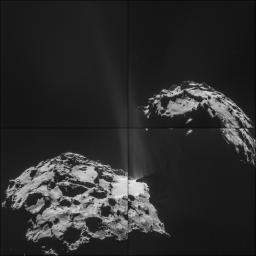The four images that make up a new montage of comet 67P/Churyumov-Gerasimenko were taken on September 26, 2014 by the European Space Agency's Rosetta spacecraft. At the time, Rosetta was about 16 miles (26 kilometers) from the center of the comet.
In the montage, a region of jet activity can be seen at the neck of the comet. These jets, originating from several discrete locations, are a product of ices sublimating and gases escaping from inside the nucleus.
The overlapping and slightly dissimilar angles of the four images that compose the montage are a result of the combined effect of the comet rotating between the first and last images taken in the sequence (about 10 degrees over 20 minutes), and the spacecraft movement during that same time.
Launched in March 2004, Rosetta was reactivated in January 2014 after a record 957 days in hibernation. Rosetta is composed of an orbiter and lander. Its objectives since arriving at comet 67P/Churyumov-Gerasimenko earlier this month are to study the celestial object up close in unprecedented detail, prepare for landing a probe on the comet's nucleus in November, and after the landing, track the comet's changes through 2015 as it sweeps past the sun.
Comets are time capsules containing primitive material left over from the epoch when the sun and its planets formed. Rosetta's lander will obtain the first images taken from a comet's surface and will provide comprehensive analysis of the comet's possible primordial composition by drilling into the surface. Rosetta also will be the first spacecraft to witness at close proximity how a comet changes as it is subjected to the increasing intensity of the sun's radiation. Observations will help scientists learn more about the origin and evolution of our solar system and the role comets may have played in seeding Earth with water, and perhaps even life.
Rosetta is an ESA mission with contributions from its member states and NASA. Rosetta's Philae lander is provided by a consortium led by the German Aerospace Center, Cologne; Max Planck Institute for Solar System Research, Gottingen; National Center of Space Studies of France (CNES), Paris; and the Italian Space Agency, Rome. NASA's Jet Propulsion Laboratory in Pasadena, California, a division of the California Institute of Technology, manages the U.S. participation in the Rosetta mission for NASA's Science Mission Directorate in Washington.
For more information on the U.S. instruments aboard Rosetta, visit http://rosetta.jpl.nasa.gov.
More information about Rosetta is available at: http://www.esa.int/rosetta.
Rosetta NAVCAM image use is available under a Creative Commons licence.

 Planetary Data System
Planetary Data System












